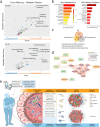Integrative multi-omics analysis uncovers tumor-immune-gut axis influencing immunotherapy outcomes in ovarian cancer
- PMID: 39638782
- PMCID: PMC11621351
- DOI: 10.1038/s41467-024-54565-8
Integrative multi-omics analysis uncovers tumor-immune-gut axis influencing immunotherapy outcomes in ovarian cancer
Abstract
Recurrent ovarian cancer patients, especially those resistant to platinum, lack effective curative treatments. To address this, we conducted a phase 2 clinical trial (NCT02853318) combining pembrolizumab with bevacizumab, to increase T cell infiltration into the tumor, and oral cyclophosphamide, to reduce the number of regulatory T cells. The trial accrued 40 heavily pretreated recurrent ovarian cancer patients. The primary endpoint, progression free survival, was extended to a median of 10.2 months. The secondary endpoints demonstrated an objective response rate of 47.5%, and disease control in 30% of patients for over a year while maintaining a good quality of life. We performed comprehensive molecular, immune, microbiome, and metabolic profiling on samples of trial patients. Here, we show increased T and B cell clusters and distinct microbial patterns with amino acid and lipid metabolism are linked to exceptional clinical responses. This study suggests the immune milieu and host-microbiome can be leveraged to improve antitumor response in future immunotherapy trials.
© 2024. The Author(s).
Conflict of interest statement
Competing interests: The authors declare no competing interests. This study was approved by the Roswell Park Institutional Review Board (IRB), and all patients provided written informed consent before initiating any study procedures. Participants did not receive financial compensation. This study followed the Consolidated Standards of Reporting Trials ( CONSORT ) reporting guideline. While all work was completed at the Roswell Park Comprehensive Cancer Center by author Shanmuga Chilakapata, this author has relocated to Northeastern University.
Figures





References
-
- Bray, F. et al. Global cancer statistics 2018: GLOBOCAN estimates of incidence and mortality worldwide for 36 cancers in 185 countries. CA Cancer J. Clinicians68, 394–424 (2018). - PubMed
-
- Siegel, R. L., Miller, K. D., Wagle, N. S. & Jemal, A. Cancer statistics, 2023. CA Cancer J. Clin.73, 17–48 (2023). - PubMed
-
- Armstrong, D. K. et al. Ovarian Cancer, Version 2.2020, NCCN Clinical Practice Guidelines in Oncology. J. Natl. Compr. Canc. Netw.19, 191–226 (2021). - PubMed
-
- Zhang, L. et al. Intratumoral T cells, recurrence, and survival in epithelial ovarian cancer. N. Engl. J. Med348, 203–213 (2003). - PubMed
Publication types
MeSH terms
Substances
Associated data
- Actions
Grants and funding
LinkOut - more resources
Full Text Sources
Medical

